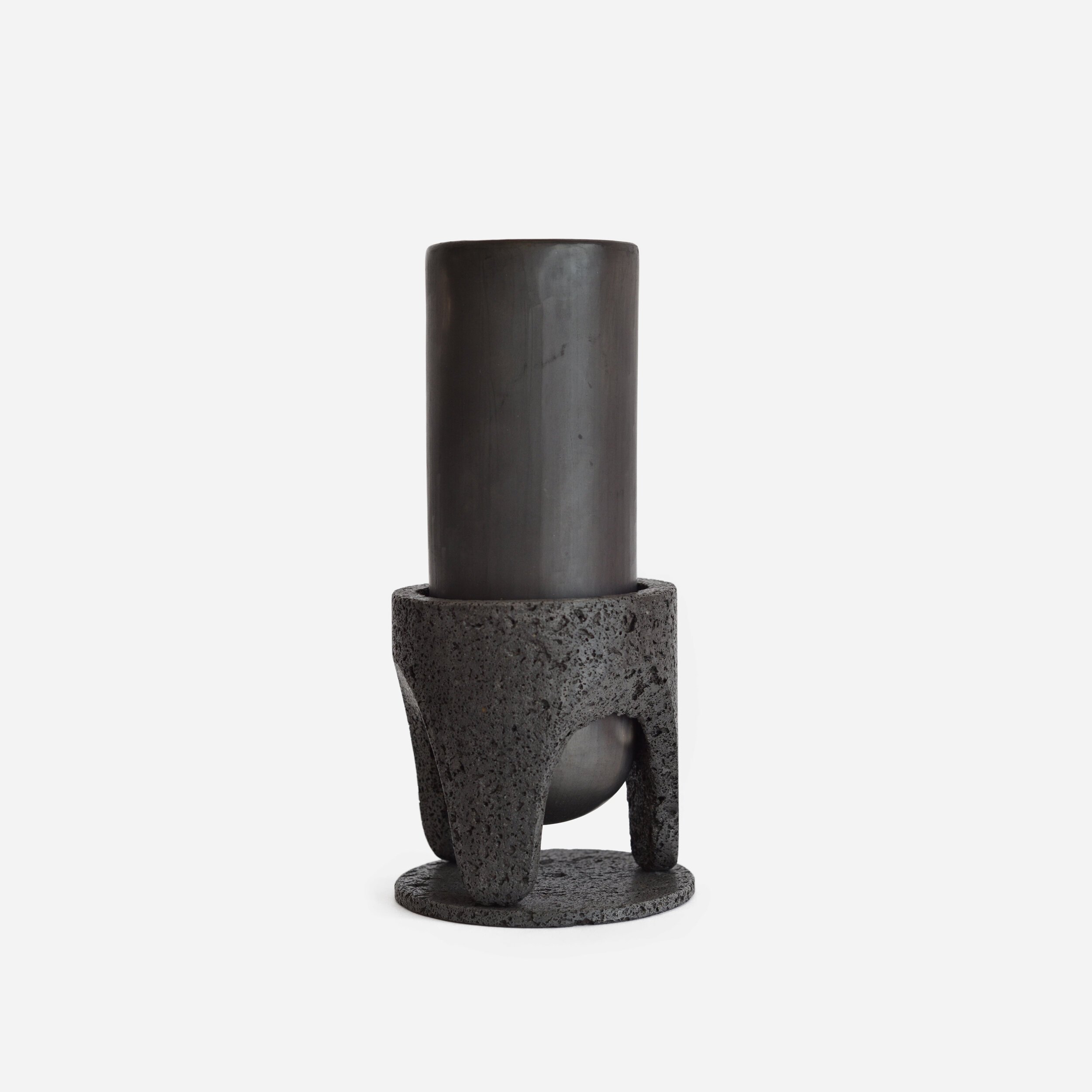The Volcano Spirit
Manantial Vessels
When mountains used to be gods
In pre-Hispanic cultures it was believed that the mountains were home to the gods. The pyramids repeated the shapes of the nearby mountains.
These same civilizations forged their identity in stone, with sculptures, stelae, columns and pyramids among others.
The collection explores the handcrafted and symbolic elements of stone. The relationship with clay, fire, water and air to create a cycle within a piece that houses these elements and creates a micro spring.
Stone that holds up clay that can contain water or fire to give way to life and the cycle repeats itself over and over again.
Manantial: spring and the cycle of nature
Is a vase that is held off the ground by a hand-carved stone base, the vase resists fire below 950 degrees so it can be used to burn charcoal inside it or incense or contain water for flowers and plants.
The vase made of black Oaxacan clay filters a very light humidity through its walls, which are cooked at a low temperature with wood and not glaze.
The base of Manantial is made of volcanic stone known as recinto.
The shape of the base is inspired by the legs of the traditional molcajete that is used to grind spices and chili peppers while the arches refer to the basic shape of the entrance to a cave creating an empty space between the ground and the black clay vase.
Xopan: Time for the green
In the Náhuatl language Xopan means “Time of green” which in turn refers to spring.
Xopan is a variation of Manantial (spring) the vase has been scratched to generate grooves that keeps seeds to germinate.
The piece transforms from a black element to a living element that germinates the green.
It is a spring itself, water that flows from the stone and mud to give life to the plants that cover the ground.
COPALERA: Decoration for the spirit, the spring of the soul.
It is a decorative piece that mixes black clay from Oaxaca and stone from Jalisco.
Two types of craftsmen with different conceptions and techniques to create a piece that pays tribute and honor to the act of decorating the space with aroma.
It is therefore an offering to the sense of smell, to the attention to that almost invisible aerial detail but without a doubt a very remarkable decoration to the nose and spirit of those who inhabit a space.
PL-B LAMP: The fire in the light, the stone and the glass
El Pedregal is a neighborhood south of Mexico City developed in the 1940s and its main developer was the famous Mexican architect Luis Barragán.
The most representative house today is the Prieto Lopez house, founded on what was once a desert area full of volcanic stone.
Nowadays the decoration of the stone floor house unites original objects of the family and recurring objects in Barragán's work, one of these objects is the blown glass spheres made in Tonala, in his native state of Jalisco.
The blown glass, transparent, spherical with an ethereal appearance that works as a light diffuser and the cylindrical stone base that refers to the ground, the verticality of the mountains and which gives solidity to the sphere, both elements were once liquid fire, moldable that merging with air and different temperature created materials that contain unique air bubbles in each piece.
Gota: The shape of the space, the shape of the water.
El espacio escultórico in Mexico City represents the emphasis of what exists there from my own interpretation. El espacio escultórico is a monumental sculpture by Federico Silva, Helen Escobedo, Hersúa, Manuel Felguérez, Mathias Goeritz and Sebastián. The almost prehistoric landscape of volcanic lava formations cloistered in this monumental sculpture of trapezoids makes evident the geometric strength of the rock forms. These rocky forms "pierce and tear" the air above, the air takes the form of the stones and in turn erodes them with gentle caresses day by day. The Gota bottle is composed of two elements, the bottle itself is handmade in black clay from Oaxaca, in the shape of a drop copying the shape of drops of water. The base for this drop to remain vertical is hand-carved volcanic stone from Jalisco, which has a ring of trapezoid prisms and in the center it has a concave shape that receives the bottle with a convex bottom, joining the two elements. Each piece takes the shape of the other. Over time, the bottle scrapes with the stone in the same way that the air erodes the volcanic stone of the sculptural space.
















